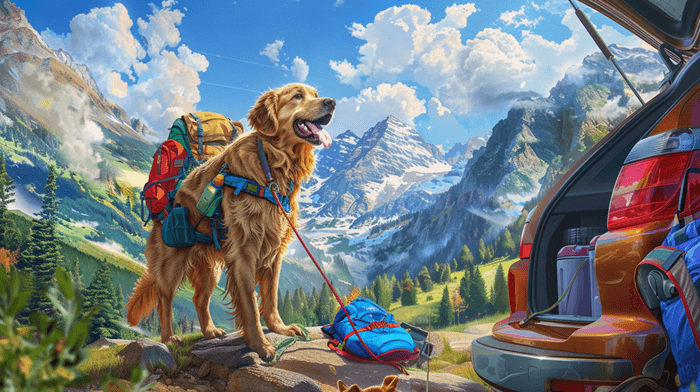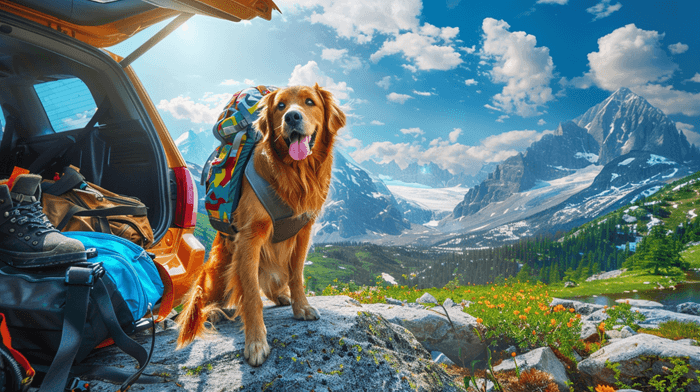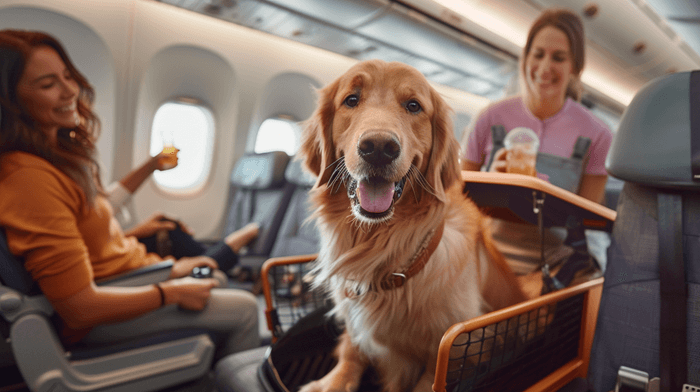
Traveling with your dog can be an incredibly rewarding experience that strengthens your bond and creates unforgettable memories. Whether you’re planning a road trip to a national park or a vacation at a pet-friendly beach, ensuring a smooth journey for both of you requires proper preparation. In this comprehensive guide, we’ll cover the benefits of traveling with your dog, essential tips for a successful trip, common mistakes to avoid, and how to make the most of your adventure together.
Benefits of Traveling with Your Dog
Before diving into the practical aspects of traveling with your dog, let’s explore some of the benefits:
- Strengthening the Bond: Sharing new experiences with your dog can strengthen the bond you share. It’s a unique way to spend quality time together, allowing both of you to create shared memories. For many pet owners, dogs are part of the family, and including them in your adventures reinforces that connection. Imagine hiking a beautiful trail or enjoying a sunset on the beach with your furry friend by your side—these moments can deepen your relationship and provide you with countless stories to reminisce about later.
- Mental Stimulation: Traveling introduces your dog to new sights, sounds, and smells, providing mental stimulation that can be very beneficial for their well-being. Dogs are naturally curious creatures, and exposure to different environments keeps their minds active. A change of scenery can prevent boredom, which is especially important for high-energy breeds that require frequent stimulation. This mental engagement can help reduce anxiety and behavioral issues, making for a happier, more balanced pet.
- Physical Activity: Traveling often involves outdoor activities, which means more exercise for both you and your dog. This can contribute to their overall health and happiness. Engaging in activities such as hiking, swimming, or running on the beach can help keep your dog fit, maintain a healthy weight, and improve their mood. Regular physical activity is essential for dogs, and incorporating exercise into your travel plans ensures they remain healthy and energetic.
- Socialization Opportunities: Traveling exposes your dog to different environments and people, helping them become more adaptable and socially engaged. Socialization is critical for a dog’s development and can help prevent behavioral problems. When your dog encounters new people and other animals during your travels, they learn how to interact appropriately, which can lead to a more well-rounded and confident pet.
- Creating Lasting Memories: The adventures you embark on with your dog can lead to cherished memories that last a lifetime. Whether it’s exploring a new city, hiking a scenic trail, or lounging by the lake, these experiences create bonds that you and your dog will treasure forever. You can capture these moments in photos, which can later be shared with friends and family, further enhancing the joy of your travels.
Step 1: Pre-Trip Preparation

Preparing for your trip is crucial for a successful journey with your dog. Here are some key steps to follow:
- Check Health and Vaccination Status: Ensure your dog is up to date on vaccinations and check with your veterinarian for any specific health concerns related to your travel destination. Some locations may require specific vaccinations, such as rabies, and it’s essential to have documentation. Additionally, if your dog has any pre-existing health conditions, discuss potential travel challenges with your vet.
- Get a Comfortable Carrier or Crate: If you’re traveling by car or plane, invest in a high-quality carrier or crate that is comfortable for your dog. It should provide enough space for them to stand up, turn around, and lie down. Ensure the crate is well-ventilated and secured in your vehicle to prevent any accidents during travel. Familiarizing your dog with their crate before the trip can also help ease anxiety.
- Pack Essential Supplies: Make a packing list of all the necessary items for your dog. This includes food, water, bowls, leash, waste bags, grooming supplies, and any medications they may need. Additionally, consider bringing their favorite toys or a blanket to help them feel comfortable in new surroundings. Packing a first-aid kit for your dog is also a wise precaution. Include items like bandages, antiseptic wipes, tweezers, and any specific medications your dog may require.
- Prepare Your Dog for Travel: Before your trip, take your dog on shorter excursions to help them acclimate to the idea of traveling. This can involve car rides or visits to different parks. This not only helps them get used to the car but also allows you to gauge how they handle new experiences.
Step 2: Research Your Destination

Not all places are pet-friendly, so it’s essential to research your destination thoroughly:
- Pet-Friendly Accommodations: Look for hotels, vacation rentals, or campsites that allow dogs. Websites like BringFido and Airbnb often have options that cater to pet owners. When booking, inquire about their pet policy, including any fees or restrictions. Some places may have breed restrictions or limit the number of pets allowed.
- Local Parks and Activities: Research parks, beaches, and other activities that welcome dogs. This way, you can plan a fun itinerary for both of you. Many cities have dog parks, hiking trails, and beaches where your dog can play and socialize. Look for events in the area that might be dog-friendly, such as outdoor festivals or farmers’ markets.
- Emergency Vet Clinics: Before you leave, locate nearby veterinary clinics or emergency animal hospitals at your destination. This will ensure that you know where to go in case of an emergency. It can also be helpful to have the contact information for local pet sitters or doggy daycares if you plan to attend events where dogs are not allowed.
Step 3: Traveling by Car

If you’re driving to your destination, follow these tips for a smooth car ride:
- Familiarize Your Dog with the Car: Before the trip, take your dog for short car rides to help them acclimate. This will reduce anxiety during longer journeys. You can also reward your dog with treats and praise during these practice runs to create positive associations with car travel.
- Use Restraints for Safety: Always use a pet seatbelt or crate to keep your dog safe while driving. This prevents distractions and protects them in case of an accident. Additionally, securing your dog minimizes the risk of them jumping around the vehicle, which can be dangerous for both the dog and the driver.
- Schedule Regular Breaks: Plan stops every couple of hours to let your dog stretch their legs, hydrate, and relieve themselves. Use these breaks as an opportunity for both of you to move around and enjoy some fresh air. When stopping, always ensure your dog is on a leash and away from busy roads.
- Stay Calm and Positive: Your dog can pick up on your emotions, so maintaining a calm and positive demeanor during the trip is essential. If your dog seems anxious, speak softly and reassure them. Playing soothing music or using a calming spray designed for pets can help ease anxiety during travel.
Step 4: Accommodation Booking

When booking accommodation, make sure to keep your dog in mind:
- Reserve in Advance: Popular pet-friendly accommodations can fill up quickly, so it’s best to book early. This will ensure you have a place to stay and avoid last-minute surprises. Consider calling ahead to confirm the details of your reservation and discuss any specific needs your dog may have.
- Consider Camping Options: If you enjoy nature, consider camping. Many campsites are pet-friendly and provide the opportunity to enjoy the natural beauty with your dog by your side. Camping can be a fantastic way to bond with your dog while enjoying the great outdoors. Ensure you check the campsite’s pet policy and any rules related to leashing and waste disposal.
- Pack Pet-Specific Items: When packing for your accommodation, remember to bring items that will make your dog comfortable. This includes their bed, favorite toys, and any items that smell like home. Having familiar scents can help alleviate anxiety in new environments.
Step 5: Keep Your Dog Safe and Comfortable During the Trip
Once you’re on your way, ensure your dog is comfortable and secure. Here are some tips to keep them happy during the journey:
- Maintain Temperature: Make sure your dog doesn’t overheat. Keep the air conditioning on or slightly open the windows. Never leave your dog alone in the car, especially on hot days, as this can lead to heatstroke, which can be fatal. If you must stop, take your dog with you or ensure they are in a safe, shaded area.
- Bathroom and Exercise Breaks: Make regular stops for your dog to relieve themselves and stretch. This will help keep them relaxed and prevent anxiety during the trip. Use these breaks as an opportunity to let your dog sniff around and explore their surroundings.
- Stay Hydrated: Ensure your dog has access to fresh water at all times. Bring enough water and a portable bowl for them to drink when needed. Offer water regularly, especially during warm weather or after exercise.
- Watch for Signs of Stress: Pay attention to your dog’s behavior during the trip. Signs of stress may include panting, pacing, whining, or excessive barking. If you notice these behaviors, take a break to help them relax and calm down.
Step 6: Adapt to the New Environment

When you arrive at your destination, allow your dog to adjust to the new surroundings. Here are some tips:
- Gradual Exploration: Let your dog explore the new place at their own pace. Some dogs may feel overwhelmed initially, so give them time to acclimate. Start with short walks around the area to help them get familiar with the sights and sounds.
- Designate a Safe Space: Create a designated area in your accommodation where your dog can feel secure. This can be their bed or a cozy corner with their belongings. A familiar space helps them relax and feel more at home in a new environment.
- Stick to Their Routine: Try to maintain your dog’s usual feeding and walking schedule as much as possible. Consistency can provide comfort in unfamiliar situations. Bring their usual food and feeding schedule to ensure they feel secure and maintain their regular habits.
Step 7: Enjoying Activities Together
Once settled in, it’s time to enjoy your vacation with your dog. Here are some activities to consider:
- Hiking Adventures: Explore dog-friendly hiking trails in the area. Research the trails beforehand to ensure they are suitable for your dog’s fitness level. Always keep your dog on a leash and be mindful of other hikers and wildlife.
- Beach Days: If you’re near the coast, enjoy a day at the beach with your dog. Many beaches have designated dog-friendly areas where they can run and play in the water. Remember to bring fresh water, a towel, and dog-friendly sunscreen if necessary.
- Local Attractions: Visit pet-friendly parks, markets, and outdoor events where dogs are welcome. These experiences can provide socialization opportunities and allow you to explore the local culture together.
- Photography Opportunities: Capture beautiful moments with your dog during your travels. Consider bringing a camera or using your phone to take pictures of your adventures together. Not only will this create lasting memories, but it can also be a fun way to document your travels.
Common Mistakes to Avoid When Traveling with Your Dog
While traveling with your dog can be a fantastic experience, it’s essential to avoid some common mistakes that could lead to complications:
- Neglecting Health Checks: Failing to check your dog’s health and vaccination status before traveling can lead to unnecessary risks. Ensure your dog is healthy and fit for travel, especially if you plan to engage in outdoor activities.
- Forgetting Identification: Always ensure your dog has a collar with an ID tag and consider microchipping them before your trip. This is crucial in case your dog gets lost in an unfamiliar area. Include your contact information and the address of where you’re staying.
- Not Researching Regulations: Different areas have various pet regulations and leash laws. Research local rules to avoid fines or complications during your travels. Familiarize yourself with any breed-specific legislation that may affect your dog.
- Ignoring Your Dog’s Needs: It’s easy to get caught up in the excitement of traveling, but never forget to prioritize your dog’s needs. Make time for breaks, meals, and rest, and be attentive to any signs of stress or discomfort.
- Underestimating Travel Time: Plan your travel itinerary realistically. Allow for extra time for bathroom breaks, meal stops, and any unexpected delays. This will help keep the trip enjoyable for both you and your dog.
- Overpacking or Underpacking: Make a checklist of all necessary items for your dog and ensure you don’t forget anything essential. Conversely, avoid overpacking by focusing on what your dog genuinely needs for comfort and safety.
- Failing to Communicate: If you’re traveling with others, ensure everyone understands the needs of your dog and their schedule. Open communication can help prevent misunderstandings and keep everyone on the same page.
Conclusion

Traveling with your dog can be an enriching experience that strengthens your bond and creates lasting memories. By following the steps outlined in this guide, you can ensure a successful trip for both of you. From pre-trip preparation to adapting to new environments, proper planning is key. Avoid common mistakes, prioritize your dog’s needs, and embrace the adventures that await you. Whether you’re exploring new trails, relaxing on the beach, or enjoying city life, your dog will appreciate the time spent together.
If you’re planning to travel with your dog, remember to check out the Dog Trainer Bible for tips on training your furry companion. Having a well-trained dog can make your travels even more enjoyable!
